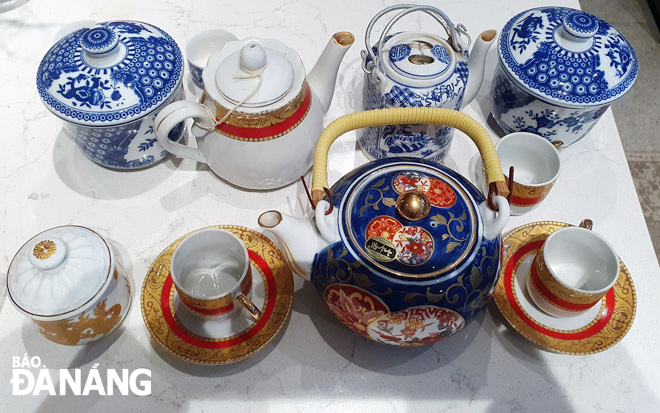Prevention of lead poisoning from crockery and porcelain
Nowadays, utensils made of crockery and porcelain such as plates, bowls, cups, and glasses, and cups are increasingly popular among consumers because of their beautiful designs and reasonable prices. However, if these products are not manufactured with safe technology, it will lead to unfortunate lead poisoning.
 |
| To avoid lead poisoning, you should avoid buying crockery, and porcelain having many patterns and colours. Photo: V.T.L |
Normally, crockery, porcelain and ceramic contain substances such as lead, and cadmium in decorative enamel or pattern. If the product does not reach the standard calcination temperature of 1,200oC to 1,500oC, the manufacturer will use a high concentration of lead additive to make the materials melt quickly at low temperatures. Also, the more patterns and the more colourful the colours, the higher the lead content.
The motifs are mostly decals or painted on enamel and fired at low temperatures to keep their vibrant colours. Therefore, it is not possible to remove all lead. When these crockery and porcelain come into contact with acidic foods such as fermented pickles, coffee, milk, wine, beer, fruit juices, sugar water, and hot soup, the lead in the pigments will flow out bit by bit. As time goes by, the amount of lead in the body accumulates to a certain level, it will cause poisoning.
According to the quote on the website sulonghau.com.vn of the Long Hau Porcelain Joint Stock Company, engineer Pham Van Lam working at the Institute of Chemistry has given some advice as well as methods to check whether crockery and porcelain are contaminated with lead by using water and vinegar, helping consumers to check for themselves whether the porcelain in the household is safe and of good quality, as well as know how to use porcelain safely.
Accordingly, people can test the heat and toxic heavy metals of ceramic dishes by soaking the product in a vinegar solution. If it shows signs of whiteness or the vinegar changes colour, it should not be used.
In case using water to test, people can pour a little water into the unglazed part of the bowl, cup, or plate (maybe the base), if it does not absorb water, the product is qualified. If you see that the product absorbs water quickly, it means that the product is not heated enough, and has lead added so it only needs to be heated at 800oC to 1,100oC (instead of 1,200oC-1,500oC) to have finished products.
Intending to reduce costs, manufacturers manually burn crockery and porcelain products according to non-standard processes to save time and cost so these products are even more toxic. On top of that, these toxic products are even more highly lead-free if they contain hot, sour foods, and fruit juices, because at high temperatures, acids, alkalis, and salts will make lead be released quickly, contaminate food and cause toxicity to the body.
Bear in mind that people should not make fermented pickles in glazed ceramic pots, not store food in glazed ceramic containers without knowing what type of glaze it is, not use dishes when the enamel is rapidly worn, and avoid daily use of lead crystal items. Especially, pregnant women should avoid the daily use of hot drinks in ceramic cups.
To avoid poisoning, do not choose to buy or use crockery and porcelain with too many colourful colours such as yellow, blue, and red to store food. Instead, people should choose a porcelain that is colourless inside. It is recommended to choose porcelain from facilities with safe production technology with a guaranteed kiln from 1,200oC - 1,500oC. When buying new crockery and porcelain, they should be soaked in vinegar, which will dissolve most of the lead remaining in the product.
Reporting by DNO- Translating by T.VY